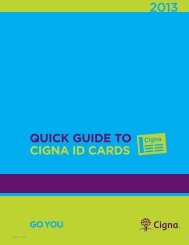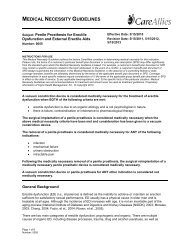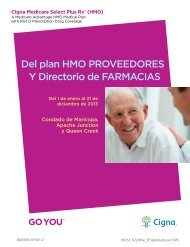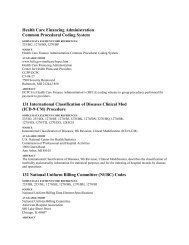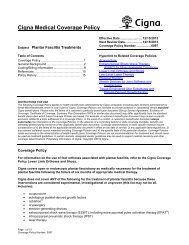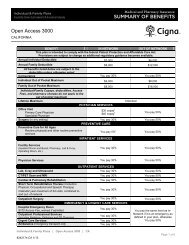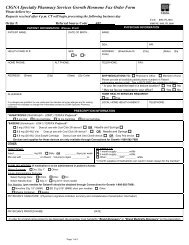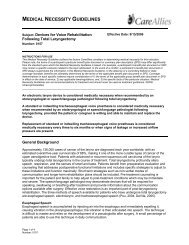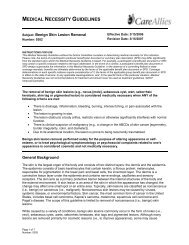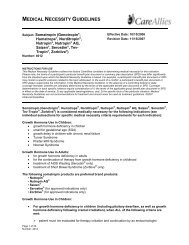Electrical Stimulators - Cigna
Electrical Stimulators - Cigna
Electrical Stimulators - Cigna
You also want an ePaper? Increase the reach of your titles
YUMPU automatically turns print PDFs into web optimized ePapers that Google loves.
of patients with chronic pain who have large areas or a large numbers of sites to be stimulated or the frequency<br />
is such that it is not feasible to use conventional electrodes, tapes or lead wires. The electrodes may also be<br />
indicated when sites requiring stimulation are not accessible by the patient with conventional electrodes, tapes<br />
or lead wires (i.e., back) and/or when medical conditions (e.g., skin problems) preclude the use of conventional<br />
electrodes, tapes or lead wires.<br />
U.S. Food and Drug Administration (FDA): AG Garments (San Diego, CA) conductive electrodes are Class II,<br />
510(k) approved by the FDA “as reusable (by a single patient), cutaneous, flexible, conductive garment/fabric<br />
electrodes for interface between electrical stimulators and a patient’s skin for the delivery of electrical<br />
stimulation” (FDA, 2002).<br />
Bioelectric Nerve Block (Electroceutical Therapy)<br />
Bioelectric therapy, also known as electromedicine, noninvasive neuron-blockade devices, electroceutical<br />
neuron-blockade devices and bioelectric treatment systems, is proposed as a treatment for acute pain and<br />
chronic pain (e.g., back pain, diabetic pain, joint pain, fibromyalgia, headache, and reflex sympathetic<br />
dystrophy). Electroceutical treatments use much higher electrical frequencies than TENS units (ranging from<br />
one to 20,000 Hz compared to 0.5 to 100 Hz used in TENS).<br />
U.S. Food and Drug Administration (FDA): An example of a device used for bioelectric therapy is the Matrix<br />
PRO ElecDT (Matrix Electromedical, Inc., Las Vegas, NV) which was 510(k) approved by the FDA as an<br />
interferential current therapy device.<br />
Literature Review: There is insufficient evidence in the published peer-reviewed scientific studies to support<br />
the safety and effectiveness of bioelectric therapy. Well-designed, randomized controlled clinical studies are<br />
needed to determine the clinical utility of electroceutical therapy in the treatment of patients with acute or chronic<br />
pain.<br />
Cranial <strong>Electrical</strong> Stimulation<br />
Cranial electrical stimulation (CES), also called electrotherapy, electrotherapeutic sleep, electrosleep, electric<br />
cerebral stimulation, cranial transcutaneous electrical nerve stimulation, cerebral electrotherapy, transcranial<br />
electrotherapy, transcranial electrical stimulation, transcranial direct electrical stimulation (tDCS), transcerebral<br />
electrotherapy, neuroelectric therapy, and craniofacial electrostimulation, delivers low level electrical stimulation<br />
(i.e., microcurrent) to the brain through electrodes that are attached to the ear lobes or behind the ears. It has<br />
been proposed that CES’s direct effect on the brain’s limbic system, hypothalamus, reticular activation system,<br />
and/or the autonomic nervous system can control the symptoms of various conditions. This therapy is not to be<br />
confused with transcranial magnetic stimulation or vagus nerve stimulation. CES has been proposed for the<br />
treatment of anxiety, depression, insomnia, substance abuse, fibromyalgia, Alzheimer’s, attentiondeficit/hyperactivity<br />
disorder (ADHD), asthma, spastic colitis, tension headaches, hypertension, chemotherapy<br />
symptoms in cancer patients, burn patients, and other pain-related disorders.<br />
U.S. Food and Drug Administration (FDA): CES devices are approved under the FDA 510(k) class III process<br />
for the treatment of insomnia, depression, or anxiety. Examples of these devices include the Cranial <strong>Electrical</strong><br />
Nerve Stimulator (Johari Digital Healtcare Ltd., Fall CITY, WA), Alpha-Stim ® (Electromedical Products, Inc.,<br />
Hawthorne, CA), and LISS Cranial Stimulator and Fisher-Wallace Cranial Stimulator by Medical Consultants Intl.<br />
Ltd. (Glen Rock, NJ). Some devices are approved for use by the patient at home.<br />
Literature Review: The evidence in the published peer-reviewed literature does not support the effectiveness of<br />
CES for any indication. Studies consist of randomized trials with small patient populations, short-term followups,<br />
and conflicting outcomes.<br />
Alzheimers: Rose et al. (2009) conducted a randomized controlled trial to compare the short-term effects of<br />
CES (Alpha-Stim) (n=19) to sham stimulation (n=19) on sleep disturbance, depressive symptoms, and<br />
subjective appraisal in individuals who were the primary caregivers for spouses with Alzheimer’s disease.<br />
Subjects used CES 60 minutes per day for four weeks and completed a daily log. At the end of four weeks,<br />
there were no significant differences in overall sleep disturbances, sleep quality, or sleep onset latency scores.<br />
The CES group did report a nine-minute decrease in sleep onset latency compared to a one minute increase in<br />
Page 9 of 41



